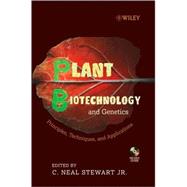
Note: Supplemental materials are not guaranteed with Rental or Used book purchases.
Purchase Benefits
Looking to rent a book? Rent Plant Biotechnology and Genetics : Principles, Techniques and Applications [ISBN: 9780470043813] for the semester, quarter, and short term or search our site for other textbooks by Stewart, C. Neal. Renting a textbook can save you up to 90% from the cost of buying.
C. Neal Stewart Jr. PhD, holds the Racheff Chair of Excellence in Plant Molecular Genetics and is a Professor in the Department of Plant Sciences at the University of Tennessee, Knoxville. Dr. Stewart serves on the editorial boards of BMC Biotechnology, Sensors, and Trends in Plant Science, and is an Associate Editor for In Vitro Developmental and Cellular Biology—Plant.
| Preface | |
| Foreword to Plant Biotechnology and Genetics | |
| Contributors | |
| Plant Agriculture: The Impact of Biotechnology | |
| Chapter Summary and Objectives | |
| Summary | |
| Discussion Questions | |
| Introduction | |
| Biotechnology Crops Plantings | |
| Why Farmers Use Biotech Crops | |
| Herbicide-Tolerant Crops | |
| Insect-Resistant Crops | |
| Conclusion | |
| How the Adoption of Plant Biotechnology Has Impacted the Environment | |
| Environmental Impacts from Changes in Insecticide and Herbicide Use | |
| Impact on Greenhouse Gas (GHG) Emissions | |
| Conclusions | |
| References | |
| Mendelian Genetics and Plant Reproduction | |
| Chapter Summary and Objectives | |
| Summary | |
| Discussion Questions | |
| Genetics Overview | |
| Mendelian Genetics | |
| Law of Segregation | |
| Law of Independent Assortment | |
| Mitosis and Meiosis | |
| Mitosis | |
| Meiosis | |
| Recombination | |
| Cytogenetic Analysis | |
| Plant Reproductive Biology | |
| History of Research | |
| Mating Systems | |
| Sexual Reproduction | |
| Asexual Reproduction | |
| Mating Systems Summary | |
| Hybridization and Polyploidy | |
| Conclusion | |
| References | |
| Plant Breeding | |
| Chapter Summary and Objectives | |
| Summary | |
| Discussion Questions | |
| Introduction | |
| Central Concepts in Plant Breeding | |
| Simple versus Complex Inheritance | |
| Phenotype versus Genotype | |
| Mating Systems, Varieties, Landraces, and Pure Lines | |
| Other Topics in Population and Quantitative Genetics | |
| The Value of a Plant Variety Depends on Many Traits | |
| Varieties Must Be Adapted to Environments | |
| Plant Breeding Is a Numbers Game | |
| Plant Breeding Is an Iterative and Collaborative Process | |
| Diversity, Adaptation, and Ideotypes | |
| Other Considerations | |
| Objectives for Plant Breeding | |
| Methods of Plant Breeding | |
| Methods of Hybridization | |
| Self-Pollinated Species | |
| Outcrossing Species | |
| Synthetic Varieties | |
| Hybrid Varieties | |
| Clonally Propagated Species | |
| Breeding Enhancements | |
| Doubled Haploidy | |
| Marker-Assisted Selection | |
| Mutation Breeding | |
| Apomixis | |
| Conclusions | |
| References | |
| Plant Development and Physiology | |
| Chapter Summary and Objectives | |
| Summary | |
| Discussion Questions | |
| Plant Anatomy and Morphology | |
| Embryogenesis and Seed Germination | |
| Gametogenesis | |
| Fertilization | |
| Fruit Development | |
| Embryogenesis | |
| Seed Germination | |
| Photomorphogenesis | |
| Meristems | |
| Shoot Apical Meristem | |
| Root Apical Meristem and Root Development | |
| Leaf Development | |
| Leaf Structure | |
| Leaf Development Patterns | |
| Flower Development | |
| Floral Evocation | |
| Floral Organ Identity and the ABC Model | |
| Hormone Physiology and Signal Transduction | |
| Seven Plant Hormones and Their Actions | |
| Plant Hormone Signal Transduction | |
| Auxin and GA Signaling | |
| Cytokinin and Ethylene Signaling | |
| Brassinosteroid Signal Transduction | |
| Conclusions | |
| References | |
| Tissue Culture: The Manipulation of Plant Development | |
| Chapter Summary and Objectives | |
| Table of Contents provided by Publisher. All Rights Reserved. |
The New copy of this book will include any supplemental materials advertised. Please check the title of the book to determine if it should include any access cards, study guides, lab manuals, CDs, etc.
The Used, Rental and eBook copies of this book are not guaranteed to include any supplemental materials. Typically, only the book itself is included. This is true even if the title states it includes any access cards, study guides, lab manuals, CDs, etc.